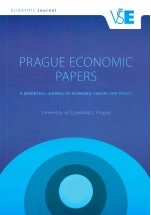A factor-augmented vector autoregressive approach to analyse the transmission of monetary policy
A factor-augmented vector autoregressive approach to analyse the transmission of monetary policy
Author(s): Zulfiqar Ali Wagan, Zhang Chen, Hakimzadi WaganSubject(s): Social Sciences, Economy, Public Finances
Published by: Vysoká škola ekonomická v Praze
Keywords: monetary policy; FAVAR; VAR; Bayesian methods
Summary/Abstract: Using the factor-augmented vector autoregressive (FAVAR) model proposed by Bernanke et al. (2005), this study explores the effect of monetary policy on a wide range of macroeconomic and financial variables for the US, Canada and the UK. The study makes use of financial data from 1990 to 2016, comprising 55–70 variables of the three major nations to show (1) that factors come with additional informational capability, which summarizes the performance of key macroeconomic variables and (2) the manner in which these variables are affected by contractionary monetary policies. Our findings confirm that monetary policy tightening results in decrease in industrial production, employment, share prices, housing starts and inflation; however, it leads to increase in the three-month treasury bill rate, long-term interest rates and unemployment. Overall, the impact of standardized monetary tightening is similar across the countries studied. These results from the major economies and the inclusion of larger data sets containing more variables would be relevant for policy theorists and practitioners from other countries.
Journal: Prague Economic Papers
- Issue Year: 28/2019
- Issue No: 6
- Page Range: 709-728
- Page Count: 20
- Language: English

